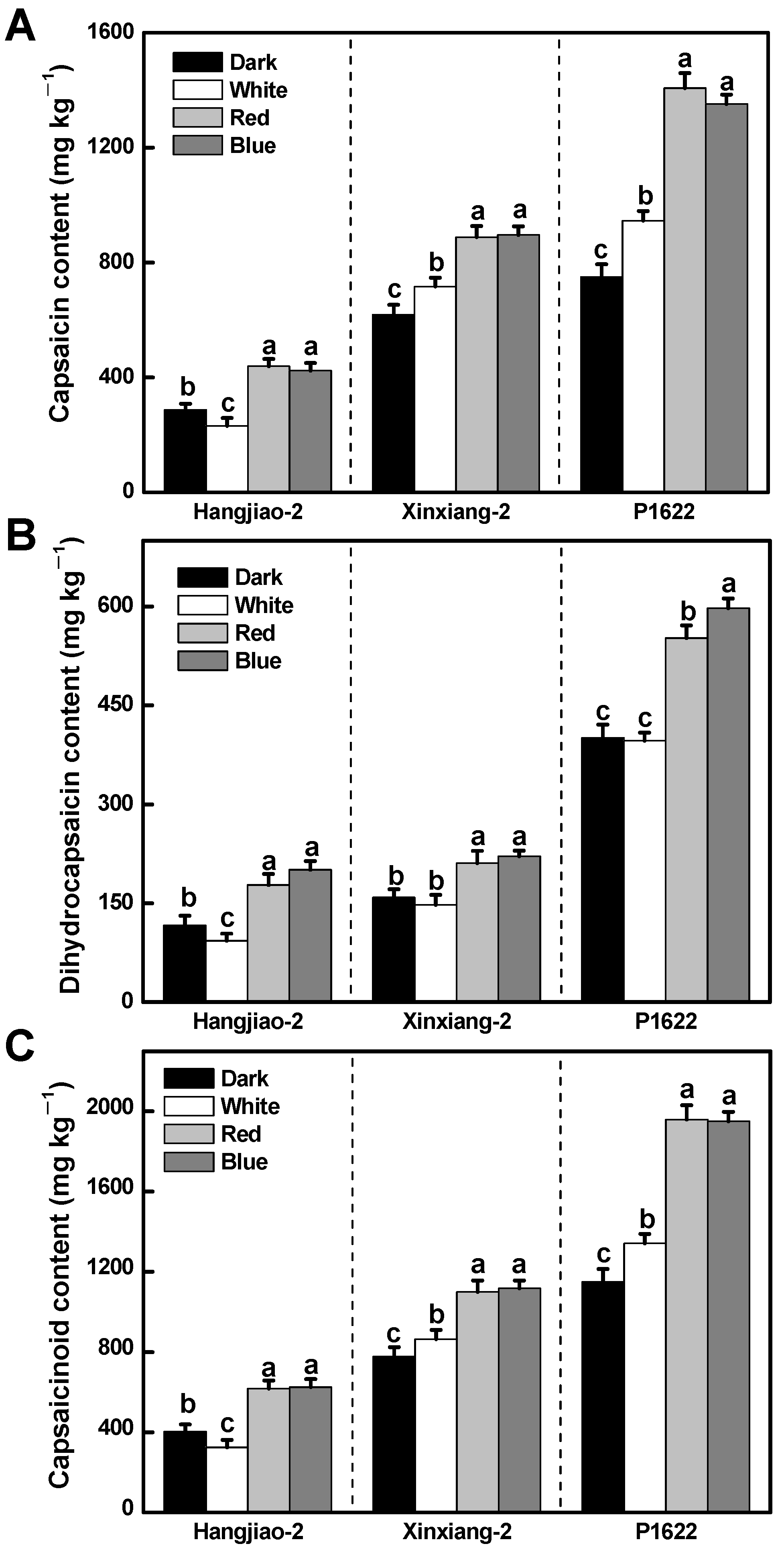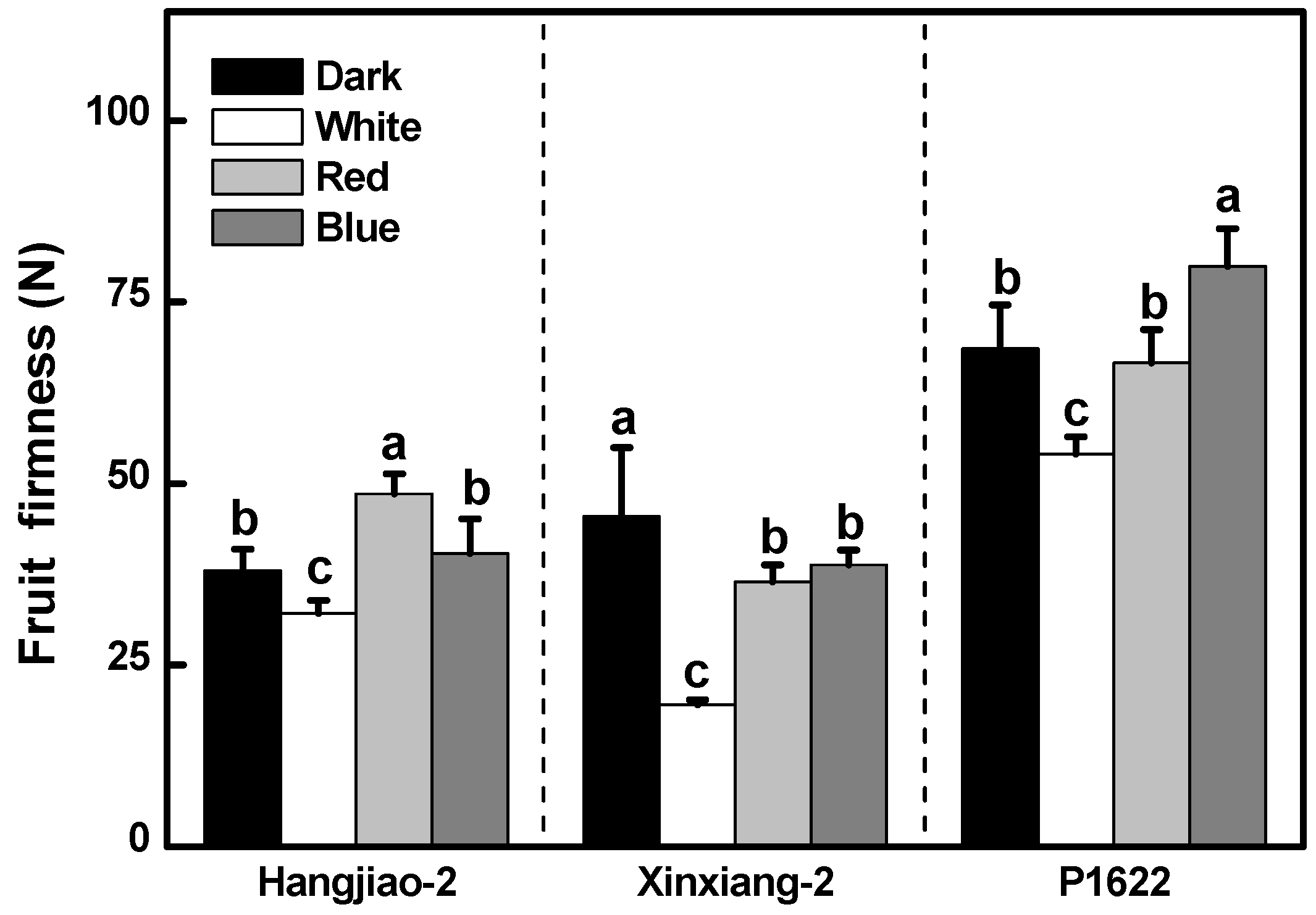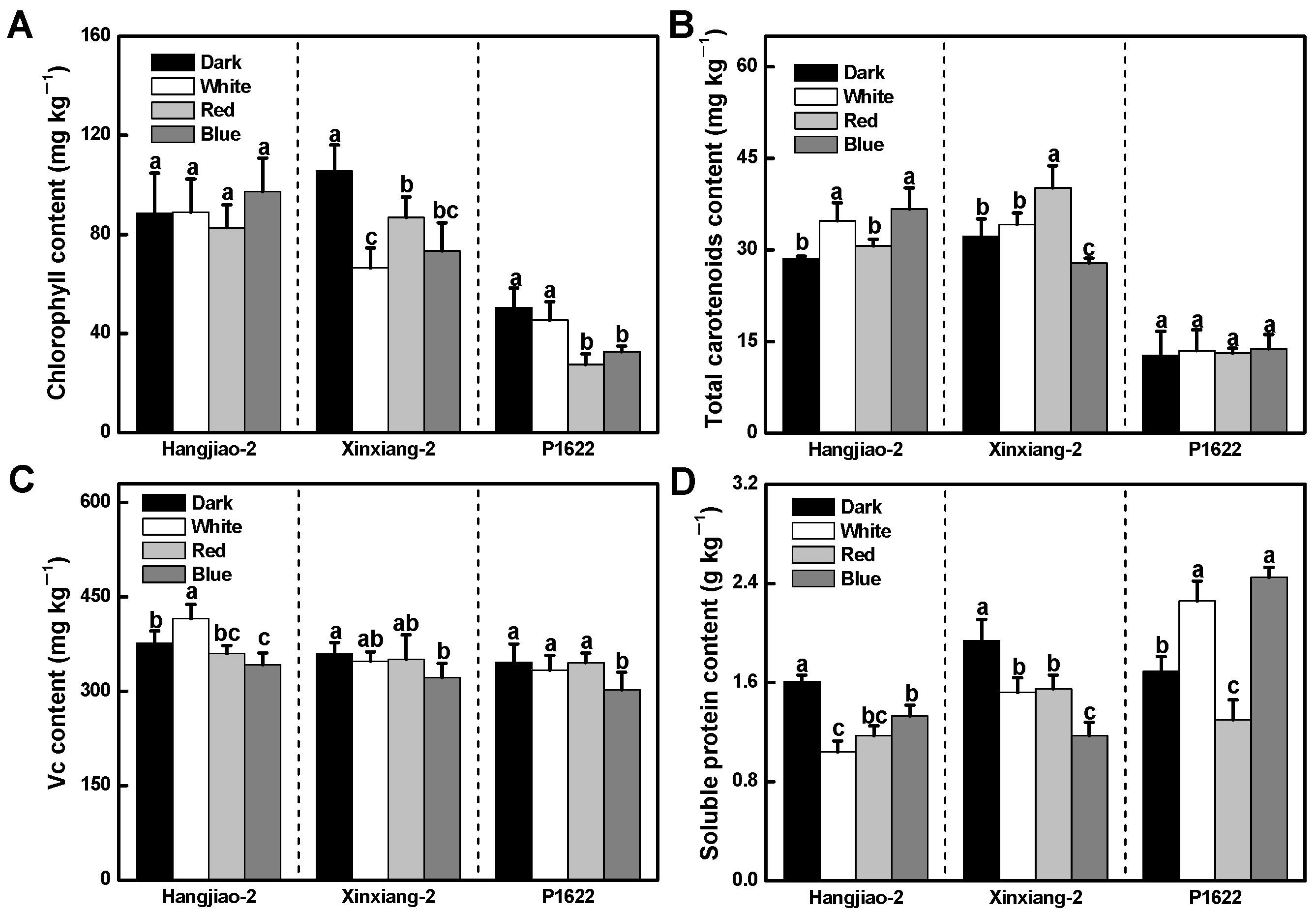Post-Harvest LED Light Irradiation Affects Firmness, Bioactive Substances, and Amino Acid Compositions in Chili Pepper (Capsicum annum L.)
Abstract
:1. Introduction
2. Materials and Methods
2.1. Plant Materials and Growth Conditions
2.2. Soluble Protein Content Determination
2.3. Determination of Total Chlorophyll and Carotenoids Contents
2.4. HPLC Analysis of Capsaicin and Ascorbic Acid (Vitamin C)
2.5. Total Amino Acid Composition Determination
2.6. Statistical Analysis and Design
3. Results
3.1. Effects of Light Treatments on Capsaicinoid Content of Pepper Fruits
3.2. Effect of Light Treatments on the Firmness of Pepper Fruits
3.3. Effects of Light Treatments on the Nutritional Quality of Pepper Fruits
3.4. Effects of Light Treatments on the Amino Acid Composition and Content of Pepper Fruits
| Hangjiao-2 | Xinxiang-2 | P1622 | ||||||||||
|---|---|---|---|---|---|---|---|---|---|---|---|---|
| Dark | White | Red | Blue | Dark | White | Red | Blue | Dark | White | Red | Blue | |
| T | 37.0 ±2.1 c | 40.6 ±2.3 b | 54.3 ±3.6 a | 52.1 ±3.1 a | 37.2 ±2.1 b | 35.0 ±2.0 c | 33.8 ±1.9 c | 38.8 ±2.4 a | 36.4 ±1.9 a | 31.6 ±1.6 b | 32.4 ±1.7 b | 32.8 ±1.9 b |
| A | 14.8 ±0.8 c | 17.8 ±1.1 b | 22.3 ±1.5 a | 21.4 ±1.4 a | 14.9 ±1.0 ab | 14.7 ±0.9 ab | 14.3 ±0.9 b | 15.5 ±1.1 a | 13.9 ±0.7 a | 12.7 ±0.6 b | 13.0 ±0.6 b | 12.6 ±0.6 b |
| B | 22.3 ±1.3 b | 22.8 ±1.2 b | 31.9 ±2.1 a | 30.8 ±1.7 a | 22.3 ±1.2 a | 20.3 ±1.1 b | 19.5 ±1.1 b | 23.3 ±1.3 a | 22.5 ±1.2 a | 18.9 ±1.0 c | 19.4 ±1.1 c | 20.2 ±1.3 b |
| C | 3.1 ±0.2 b | 3.3 ±0.2 b | 4.7 ±0.3 a | 4.5 ±0.4 a | 3.3 ±0.1 b | 3.0 ±0.2 c | 2.7 ±0.1 c | 3.6 ±0.2 a | 3.8 ±0.3 a | 3.0 ±0.2 c | 2.8 ±0.2 d | 3.6 ±0.2 b |
| D | 7.1 ±0.5 b | 6.8 ±0.3 b | 11.1 ±0.8 a | 10.8 ±0.5 a | 8.0 ±0.5 a | 6.6 ±0.3 b | 6.0 ±0.3 c | 8.2 ±0.5 a | 8.0 ±0.4 a | 6.4 ±0.3 d | 6.7 ±0.3 c | 7.2 ±0.4 b |
| E | 6.9 ±0.5 c | 8.1 ±0.6 b | 10.5 ±1.0 a | 9.9 ±0.9 a | 7.0 ±0.4 a | 6.6 ±0.5 b | 6.5 ±0.6 b | 7.3 ±0.6 a | 6.9 ±0.4 a | 6.0 ±0.4 b | 6.3 ±0.5 b | 6.0 ±0.5 b |
| F | 4.0 ±0.2 c | 5.0 ±0.3 b | 5.7 ±0.4 a | 5.6 ±0.3 a | 4.0 ±0.3 ab | 4.1 ±0.2 ab | 3.9 ±0.3 b | 4.2 ±0.3 a | 3.7 ±0.2 a | 3.5 ±0.2 b | 3.6 ±0.2 ab | 3.4 ±0.2 b |
| A/T% | 39.84 ±2.2 c | 43.78 ±2.7 a | 41.14 ±2.8 b | 40.96 ±2.7 b | 39.97 ±2.7 b | 41.97 ±2.6 a | 42.26 ±2.7 a | 39.90 ±2.8 b | 38.30 ±1.9 b | 40.07 ±1.9 a | 40.20 ±1.9 a | 38.51 ±1.8 b |
| B/T% | 60.16 ±3.5 a | 56.22 ±3.0 c | 58.86 ±3.9 b | 59.04 ±3.3 b | 60.03 ±3.2 a | 58.03 ±3.1 b | 57.74 ±3.3 b | 60.10 ±3.4 a | 61.70 ±3.3 a | 59.93 ±3.2 b | 59.80 ±3.4 b | 61.49 ±4.0 a |
| C/T% | 8.50 ±0.5 a | 8.04 ±0.5 b | 8.66 ±0.6 a | 8.66 ±0.8 a | 8.99 ±0.3 a | 8.44 ±0.6 b | 8.09 ±0.3 c | 9.17 ±0.5 a | 10.36 ±0.8 ab | 9.56 ±0.6 b | 8.54 ±0.6 c | 10.81 ±0.6 a |
| D/T% | 19.27 ±1.4 b | 16.68 ±0.7 c | 20.45 ±1.5 a | 20.73 ±1.0 a | 21.50 ±1.3 a | 18.79 ±0.9 b | 17.75 ±0.9 c | 21.21 ±1.3 a | 21.95 ±1.1 a | 20.16 ±0.9 b | 20.81 ±0.9 b | 21.94 ±1.2 a |
| E/T% | 18.68 ±1.4 b | 19.89 ±1.5 a | 19.43 ±1.8 a | 18.93 ±1.7 b | 18.86 ±1.1 b | 18.64 ±1.4 b | 19.20 ±1.8 a | 18.78 ±1.5 b | 18.99 ±1.1 b | 19.02 ±1.3 b | 19.41 ±1.5 a | 18.18 ±1.5 c |
| F/T% | 10.72 ±0.5 b | 12.26 ±0.7 a | 10.54 ±0.7 b | 10.83 ±0.6 b | 10.75 ±0.8 b | 11.63 ±0.6 a | 11.64 ±0.9 a | 10.81 ±0.8 b | 10.10 ±0.5 b | 11.00 ±0.6 a | 10.99 ±0.6 a | 10.44 ±0.6 ab |
3.5. Effect of Light Treatments on the Nutritional Value of Amino Acids
| Essential Amino Acids | Amino Acid Scoring Pattern * | Hangjiao-2 | Xinxiang-2 | P1622 | |||||||||
|---|---|---|---|---|---|---|---|---|---|---|---|---|---|
| Dark | White | Red | Blue | Dark | White | Red | Blue | Dark | White | Red | Blue | ||
| Thr | 2.30 | 5.34 ±0.27 a | 5.29 ±0.25 a | 5.50 ±0.37 a | 5.35 ±0.19 a | 5.20 ±0.27 b | 5.31 ±0.29 b | 5.55 ±0.30 a | 5.19 ±0.26 b | 5.09 ±0.27 b | 5.04 ±0.32 b | 5.33 ±0.31 a | 4.90 ±0.61 c |
| Val | 3.90 | 5.68 ±0.27 b | 5.92 ±0.25 a | 5.36 ±0.37 c | 5.42 ±0.38 c | 5.29 ±0.27 ab | 5.48 ±0.29 a | 5.38 ±0.30 ab | 5.12 ±0.26 b | 4.96 ±0.27 b | 5.22 ±0.32 a | 5.37 ±0.31 a | 5.05 ±0.30 b |
| Ile | 3.00 | 4.28 ±0.27 a | 4.39 ±0.25 a | 4.23 ±0.37 a | 4.29 ±0.19 a | 4.13 ±0.27 b | 4.45 ±0.29 a | 4.44 ±0.30 a | 4.07 ±0.52 b | 3.82 ±0.27 b | 4.18 ±0.32 a | 4.16 ±0.31 a | 4.23 ±0.30 a |
| Leu | 5.90 | 10.36 ±0.54 b | 11.31 ±0.99 a | 10.44 ±0.55 b | 10.54 ±0.77 b | 10.26 ±0.81 b | 10.87 ±0.86 a | 11.12 ±0.59 a | 10.29 ±0.77 b | 9.80 ±0.55 b | 10.43 ±0.32 a | 10.19 ±0.31 ab | 9.84 ±0.30 b |
| Lys | 4.50 | 7.72 ±0.54 b | 8.34 ±0.49 a | 7.77 ±0.55 b | 7.86 ±0.58 b | 7.46 ±0.54 ab | 7.71 ±0.57 a | 7.25 ±0.30 b | 7.50 ±0.26 ab | 7.20 ±0.27 b | 7.46 ±0.32 ab | 7.61 ±0.31 a | 7.25 ±0.30 b |
| Met + Cys | 2.20 | 1.78 ±0.11 b | 1.66 ±0.12 b | 1.96 ±0.13 a | 1.57 ±0.10 b | 1.79 ±0.08 a | 1.86 ±0.11 a | 1.89 ±0.09 a | 1.89 ±0.08 a | 1.98 ±0.11 a | 1.79 ±0.13 b | 1.60 ±0.09 c | 1.61 ±0.09 c |
| Phe + Tyr | 3.80 | 11.09 ±0.54 b | 12.26 ±0.74 a | 10.54 ±0.74 c | 10.83 ±0.58 bc | 10.75 ±0.81 b | 11.63 ±0.57 a | 11.64 ±0.89 a | 10.81 ±0.77 b | 10.10 ±0.55 c | 11.00 ±0.63 a | 10.99 ±0.62 a | 10.44 ±0.61 b |
4. Discussion
5. Conclusions
Supplementary Materials
Author Contributions
Funding
Institutional Review Board Statement
Informed Consent Statement
Data Availability Statement
Conflicts of Interest
References
- Molla, M.R.; Rohman, M.M.; Islam, M.R.; Hasanuzzaman, M.; Hassan, L. Screening and evaluation of chilli (Capsicum annuum L.) genotypes for waterlogging tolerance at seedling stage. Biocell 2022, 46, 1613–1627. [Google Scholar] [CrossRef]
- Arce-Rodriguez, M.L.; Ochoa-Alejo, N. Biochemistry and molecular biology of capsaicinoid biosynthesis: Recent advances and perspectives. Plant Cell Rep. 2019, 38, 1017–1030. [Google Scholar] [CrossRef] [PubMed]
- Mendes, N.D.; Goncalves, E.C.B.D. The role of bioactive components found in peppers. Trends Food Sci. Technol. 2020, 99, 229–243. [Google Scholar] [CrossRef]
- Blekkenhorst, L.C.; Sim, M.; Bondonno, C.P.; Bondonno, N.P.; Ward, N.C.; Prince, R.L.; Devine, A.; Lewis, J.R.; Hodgson, J.M. Cardiovascular Health Benefits of Specific Vegetable Types: A Narrative Review. Nutrients 2018, 10, 595. [Google Scholar] [CrossRef]
- Olatunji, T.L.; Afolayan, A.J. The suitability of chili pepper (Capsicum annuum L.) for alleviating human micronutrient dietary deficiencies: A review. Food Sci. Nutr. 2018, 6, 2239–2251. [Google Scholar] [CrossRef] [PubMed]
- Thilini Deepashika Perera, W.P.; Navaratne, S.; Wickramasinghe, I. Impact of spectral composition of light from light-emitting diodes (LEDs) on postharvest quality of vegetables: A review. Postharvest Biol. Technol. 2022, 191, 111955. [Google Scholar] [CrossRef]
- Zhang, X.; Zhang, M.; Xu, B.; Mujumdar, A.S.; Guo, Z. Light-emitting diodes (below 700 nm): Improving the preservation of fresh foods during postharvest handling, storage, and transportation. Compr. Rev. Food Sci. Food Saf. 2022, 21, 106–126. [Google Scholar] [CrossRef] [PubMed]
- Poonia, A.; Pandey, S.; Vasundhara. Application of light emitting diodes (LEDs) for food preservation, post-harvest losses and production of bioactive compounds: A review. Food Prod. Process. Nutr. 2022, 4, 8. [Google Scholar] [CrossRef]
- Huang, J.Y.; Xu, F.Y.; Zhou, W.B. Effect of LED irradiation on the ripening and nutritional quality of postharvest banana fruit. J. Sci. Food Agric. 2018, 98, 5486–5493. [Google Scholar] [CrossRef]
- Ngcobo, B.L.; Bertling, I.; Clulow, A.D. Post-harvest alterations in quality and health-related parameters of cherry tomatoes at different maturity stages following irradiation with red and blue LED lights. J. Hortic. Sci. Biotechnol. 2021, 96, 383–391. [Google Scholar] [CrossRef]
- Shi, L.Y.; Cao, S.F.; Shao, J.R.; Chen, W.; Yang, Z.F.; Zheng, Y.H. Chinese bayberry fruit treated with blue light after harvest exhibit enhanced sugar production and expression of cryptochrome genes. Postharvest Biol. Technol. 2016, 111, 197–204. [Google Scholar] [CrossRef]
- Xu, F.; Shi, L.Y.; Chen, W.; Cao, S.F.; Su, X.G.; Yang, Z.F. Effect of blue light treatment on fruit quality, antioxidant enzymes and radical-scavenging activity in strawberry fruit. Sci. Hortic. 2014, 175, 181–186. [Google Scholar] [CrossRef]
- Barcena, A.; Martinez, G.; Costa, L. Low intensity light treatment improves purple kale (Brassica oleracea var. sabellica) postharvest preservation at room temperature. Heliyon 2019, 5, e02467. [Google Scholar] [CrossRef] [PubMed]
- Song, Y.; Qiu, K.; Gao, J.; Kuai, B.K. Molecular and physiological analyses of the effects of red and blue LED light irradiation on postharvest senescence of pak choi. Postharvest Biol. Technol. 2020, 164, 111155. [Google Scholar] [CrossRef]
- Perez-Ambrocio, A.; Guerrero-Beltran, J.A.; Aparicio-Fernandez, X.; Avila-Sosa, R.; Hernandez-Carranza, P.; Cid-Perez, S.; Ochoa-Velasco, C.E. Effect of blue and ultraviolet-C light irradiation on bioactive compounds and antioxidant capacity of habanero pepper (Capsicum chinense) during refrigeration storage. Postharvest Biol. Technol. 2018, 135, 19–26. [Google Scholar] [CrossRef]
- Gangadhar, B.H.; Mishra, R.K.; Pandian, G.; Park, S.W. Comparative Study of Color, Pungency, and Biochemical Composition in Chili Pepper (Capsicum annuum) under Different Light-emitting Diode Treatments. HortScience 2012, 47, 1729–1735. [Google Scholar] [CrossRef]
- Zhao, Y.T.; Yue, Z.C.; Zhong, X.M.; Lei, J.L.; Tao, P.; Li, B.Y. Distribution of primary and secondary metabolites among the leaf layers of headed cabbage (Brassica oleracea var. capitata). Food Chem. 2020, 312, 126028. [Google Scholar] [CrossRef]
- Arce-Rodriguez, M.L.; Ochoa-Alejo, N. Silencing AT3 gene reduces the expression of pAmt, BCAT, Kas, and Acl genes involved in capsaicinoid biosynthesis in chili pepper fruits. Biol. Plant. 2015, 59, 477–484. [Google Scholar] [CrossRef]
- Liu, H.R.; Meng, F.L.; Miao, H.Y.; Chen, S.S.; Yin, T.T.; Hu, S.S.; Shao, Z.Y.; Liu, Y.Y.; Gao, L.X.; Zhu, C.Q.; et al. Effects of postharvest methyl jasmonate treatment on main health-promoting components and volatile organic compounds in cherry tomato fruits. Food Chem. 2018, 263, 194–200. [Google Scholar] [CrossRef]
- FAO; WHO; UNU. Protein and amino acid requirements in human nutrition. In Report of a Joint FAO/WHO/UNU Expert Consultation; Technical Report Series; World Health Organization: Geneva, Switzerland, 2007. [Google Scholar]
- Wang, D.C.; Ding, C.Q.; Feng, Z.; Ji, S.Y.; Cui, D. Recent advances in portable devices for fruit firmness assessment. Crit. Rev. Food Sci. Nutr. 2021. [Google Scholar] [CrossRef]
- Bian, Z.H.; Yang, Q.C.; Liu, W.K. Effects of light quality on the accumulation of phytochemicals in vegetables produced in controlled environments: A review. J. Sci. Food Agric. 2015, 95, 869–877. [Google Scholar] [CrossRef] [PubMed]
- Nassarawa, S.S.; Abdelshafy, A.M.; Xu, Y.Q.; Li, L.; Luo, Z.S. Effect of Light-Emitting Diodes (LEDs) on the Quality of Fruits and Vegetables During Postharvest Period: A Review. Food Bioprocess Technol. 2021, 14, 388–414. [Google Scholar] [CrossRef]
- Yap, E.S.P.; Uthairatanakij, A.; Laohakunjit, N.; Jitareerat, P.; Vaswani, A.; Magana, A.A.; Morre, J.; Maier, C.S. Plant growth and metabolic changes in ‘Super Hot’ chili fruit (Capsicum annuum) exposed to supplemental LED lights. Plant Sci. 2021, 305, 110826. [Google Scholar] [CrossRef] [PubMed]
- Jain, V.; Chawla, S.; Choudhary, P.; Jain, S. Post-harvest calcium chloride treatments influence fruit firmness, cell wall components and cell wall hydrolyzing enzymes of Ber (Ziziphus mauritiana Lamk.) fruits during storage. J. Food Sci. Technol. 2019, 56, 4535–4542. [Google Scholar] [CrossRef] [PubMed]
- Liu, B.; Wang, K.; Shu, X.; Liang, J.; Fan, X.; Sun, L. Changes in fruit firmness, quality traits and cell wall constituents of two highbush blueberries (Vaccinium corymbosum L.) during postharvest cold storage. Sci. Hortic. 2019, 246, 557–562. [Google Scholar] [CrossRef]
- Mohebbi, S.; Babalar, M.; Zamani, Z.; Askari, M.A. Influence of early season boron spraying and postharvest calcium dip treatment on cell-wall degrading enzymes and fruit firmness in ‘Starking Delicious’ apple during storage. Sci. Hortic. 2020, 259, 108822. [Google Scholar] [CrossRef]
- Moggia, C.; Beaudry, R.M.; Retamales, J.B.; Lobos, G.A. Variation in the impact of stem scar and cuticle on water loss in highbush blueberry fruit argue for the use of water permeance as a selection criterion in breeding. Postharvest Biol. Technol. 2017, 132, 88–96. [Google Scholar] [CrossRef]
- Najera, C.; Guil-Guerrero, J.L.; Enriquez, L.J.; Alvaro, J.E.; Urrestarazu, M. LED-enhanced dietary and organoleptic qualities in postharvest tomato fruit. Postharvest Biol. Technol. 2018, 145, 151–156. [Google Scholar] [CrossRef]
- Dhakal, R.; Baek, K.H. Metabolic alternation in the accumulation of free amino acids and gamma-aminobutyric acid in postharvest mature green tomatoes following irradiation with blue light. Hortic. Environ. Biotechnol. 2014, 55, 36–41. [Google Scholar] [CrossRef]
- Lee, Y.J.; Ha, J.Y.; Oh, J.E.; Cho, M.S. The effect of LED irradiation on the quality of cabbage stored at a low temperature. Food Sci. Biotechnol. 2014, 23, 1087–1093. [Google Scholar] [CrossRef]
- Gong, D.D.; Cao, S.F.; Sheng, T.; Shao, J.R.; Song, C.B.; Wo, F.C.; Chen, W.; Yang, Z.F. Effect of blue light on ethylene biosynthesis, signalling and fruit ripening in postharvest peaches. Sci. Hortic. 2015, 197, 657–664. [Google Scholar] [CrossRef]
- Heinemann, B.; Hildebrandt, T.M. The role of amino acid metabolism in signaling and metabolic adaptation to stress-induced energy deficiency in plants. J. Exp. Bot. 2021, 72, 4634–4645. [Google Scholar] [CrossRef]
- Yang, Q.; Zhao, D.; Liu, Q. Connections between Amino Acid Metabolisms in Plants: Lysine as an Example. Front. Plant Sci. 2020, 11, 928. [Google Scholar] [CrossRef] [PubMed]



| Cultivar | Plant Height (cm) | Canopy Width (cm) | Fruit Length (mm) | Fruit Diameter (mm) | Fruit No. Plant−1 | Single Fruit Weight (g) | Fruit Yield (g plant−1) |
|---|---|---|---|---|---|---|---|
| Hangjiao-2 | 56.3 ± 2.2 b | 72.0 ± 4.6 b | 119.6 ± 3.5 b | 22.4 ± 1.1 a | 55.5 ± 1.9 b | 18.5 ± 1.2 b | 1014.8 ± 27.9 a |
| Xinxiang-2 | 67.8 ± 2.5 a | 76.3 ± 3.3 a | 134.6 ± 3.2 a | 21.2 ± 1.0 b | 44.8 ± 5.1 a | 20.8 ± 1.0 c | 924.6 ± 163.6 a |
| P1622 | 44.8 ± 2.8 c | 71.8 ± 1.7 b | 88.9 ± 4.4 c | 11.4 ± 0.2 c | 106.5 ± 8.3 c | 5.2 ± 0.6 a | 559.3 ± 92.4 b |
Publisher’s Note: MDPI stays neutral with regard to jurisdictional claims in published maps and institutional affiliations. |
© 2022 by the authors. Licensee MDPI, Basel, Switzerland. This article is an open access article distributed under the terms and conditions of the Creative Commons Attribution (CC BY) license (https://creativecommons.org/licenses/by/4.0/).
Share and Cite
Liu, C.; Wan, H.; Yang, Y.; Ye, Q.; Zhou, G.; Wang, X.; Ahammed, G.J.; Cheng, Y. Post-Harvest LED Light Irradiation Affects Firmness, Bioactive Substances, and Amino Acid Compositions in Chili Pepper (Capsicum annum L.). Foods 2022, 11, 2712. https://doi.org/10.3390/foods11172712
Liu C, Wan H, Yang Y, Ye Q, Zhou G, Wang X, Ahammed GJ, Cheng Y. Post-Harvest LED Light Irradiation Affects Firmness, Bioactive Substances, and Amino Acid Compositions in Chili Pepper (Capsicum annum L.). Foods. 2022; 11(17):2712. https://doi.org/10.3390/foods11172712
Chicago/Turabian StyleLiu, Chaochao, Hongjian Wan, Youxin Yang, Qingjing Ye, Guozhi Zhou, Xiaorong Wang, Golam Jalal Ahammed, and Yuan Cheng. 2022. "Post-Harvest LED Light Irradiation Affects Firmness, Bioactive Substances, and Amino Acid Compositions in Chili Pepper (Capsicum annum L.)" Foods 11, no. 17: 2712. https://doi.org/10.3390/foods11172712
APA StyleLiu, C., Wan, H., Yang, Y., Ye, Q., Zhou, G., Wang, X., Ahammed, G. J., & Cheng, Y. (2022). Post-Harvest LED Light Irradiation Affects Firmness, Bioactive Substances, and Amino Acid Compositions in Chili Pepper (Capsicum annum L.). Foods, 11(17), 2712. https://doi.org/10.3390/foods11172712







